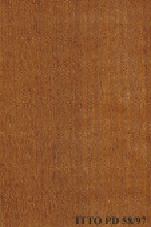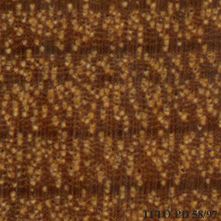
MOABI (Baillonella toxisperma)
Trade Name
Moabi
Scientific Name
Baillonella toxisperma Pierre
Family
SAPOTACEAE
Common Names
M'foi (Gabon); Adjap (Equatorial Guinea); Moabi (Congo); Adjap (Cameroon); Moabi (Angola); Ulumba; Orere; Nyabi; Ngulube; Nduku wa dijondo; Mwabi; Muyabi; Mudia; Muabi; Kungulu; Djave; Cungulo; Adjap; African pearwood (United Kingdom); Muamba jaune (Zaire); M`foi (Gabon); Dimpampi (Congo); Ayap (Equatorial Guinea); Ayap (Cameroon); Adza (Gabon); Njabi (Cameroon); Njabi (Nigeria); Moabi
Scientific Name Synonyms
Mimusops obovata Pierre ex Engl.; Mimusops djave (Laness.) Engl.; Bassia djave Laness.; Baillonella djave Pierre
Description Of The Tree
Botanical Description
The tree reaches a height of more than 50 m with straight cylindrical boles to 32 m in length. The trunk diameter attains up to 200 cm, sometimes even reaching more than 300 cm. Butt swelling is reported in older trees. Log is banned for international tra
Natural Habitat
Baillonella toxisperma is found in primary evergreen and old secondary rainforest, often in small patches on dry or moist soils.
Natural Distribution
Found in the dense equatorial forests of Africa.
Wood Identification
Anatomic Description Of Wood
Wood diffuse porous. Vessels in dendritic pattern. Vessels in diagonal and/or radial pattern. Occasionally vessels exclusively solitary (over 90%). Tangential diameter of vessel lumina 100 to 150 micras (small). Tyloses common. Non-vestured pits. Vessels per mm2 Axial parenchyma in continuous tangential lines or fine bands. Non-crystals in axial parenchyma cells. 5 to 8 cells per parenchyma strand. Axial parenchyma in narrow bands on lines up to 3 cells wide. Axial parenchyma bands more than 3 cells wide. 4 to 10 rays per mm (medium). Rays non-storied. Rays 1 to 4 seriate. Silica bodies in upright and/or square ray cells. Heterogeneous rays and/or multiseriate heterogeneous rays. Non-septate fibers. Fibers with simple to minutely bordered pits.
-
 Wood Macro Photo Tangential Plane
Wood Macro Photo Tangential Plane
-
 Wood Micro Photo Of Transversal Section
Wood Micro Photo Of Transversal Section
Availability
Cites Status
Unrestricted
General Wood Description
Color
The sapwood is dark grey to pinkish grey, it has a thickness of 4 to 6 cm. The heartwood is pink brown to red brown, it is clearly demarcated. The silver figure is fine (hardly visible).
COLOR INDEX (1=Black, 7=Light yellow,white)
3
Grain
Straight or slightly interlocked, sometimes with an influence on further processing operations.
Texture
This wood has a somewhat fine texture.
Luster
It is reported to be low in luster.
Natural Durability
Very durable to decay; without preservative treatment. This species is especially suited for all the uses with risks of permanent or long-lasting humidification. Resistant to termites attack. Heartwood is resistant to Lyctus attacks.
Natural durability index (1= Very high durability, 7=Vey low durability)
1
Internal Growth Stresses
Residual growth stresses are absent.
Silica Content
Silica Content: Silica is present. Amounts over 0.05% may affect wood processing. Silica Value: 0.19
Resistance To Impregnation
Difficult to treat with only a low penetration of the preservative products.
Wood Physical Properties
Basic Density or Specific Gravity (O.D. weight/vol. green) (g/cm³)
0.77
Air-dry Density (Weight and volume at 12%MC) (g/cm³)
0.87
Total shrinkage Tangential (Saturated to 0%MC) (%)
8.7
Total shrinkage Radial (Saturated to 0%MC) (%)
6.5
Drying Defects
Ease of Drying: Drying is moderately difficult to difficult; special care is systematically needed. Drying Defects: Risks of distortions. Kiln Schedules: Schedule proposed as a reference by comparison with well known species taking into account to the general technological behavior of this species.
Recommended Dry Kiln Schedule
FR-4
Dimensional stability ratio (Total Tangential Shrinkage %/Total Radial Shrinkage %)
1.3
Wood Chemical Properties
Wood Mechanical Properties
Bending Strength (MOR),12%MC (kgf/cm²)
1453
Stiffness (MOE) 12%MC (kgf/cm²)
214516
Compression parallel to fiber 12%MC (kgf/cm²)
750
Compression perpendicular to fiber 12%MC (kgf/cm²)
107
Shear strength radial 12%MC (kgf/cm²)
124
Janka hardness (side) 12%MC (kgf)
949
Janka hardness (end grain) 12%MC (kgf)
1003
Workability
Sawing
Sawing of this species requires powerful equipment.
Rotary Veneer Cutting
Suitable for slicing, also suitable for peeling if treated.
Sliced Veneer
Suitable for slicing, also suitable for peeling if treated.
Blunting Effect
Severe blunting effect; stellited blades for sawing and carbide tools for machining are recommended.
Machining
It needs powerful tools for processing. Possible difficulties caused by interlocked grain are reported.
Planing
Moderately easy; tools must be cautiously sharpened.
Moulding
Moderately easy; tools must be cautiously sharpened.
Turning
30
Boring
Moderately easy; tools must be cautiously sharpened.
Mortising
Moderately easy; tools must be cautiously sharpened.
Nailing
Pre-boring is necessary.
Gluing
Difficult to glue because of high density.
Sanding
Easy to perform; it gives good results.
Polishing
Can be polished without surface preparation.
Steam Bending
It is well suited for wood bending uses.
Response To Hand Tools
Working with hand tools is difficult.
REFERENCED USES
End Uses Summary
HOUSING GENERAL, beams, joists, boards, flooring, parquet, frames, steps, panelling, fittings, FURNITURE AND CABINETS, luxury furniture, cabinets, PLYWOOD AND VENEER, faces, Decorative veneer, TURNING, ornaments, turned furniture, cutlery, lasts, BENDING, chairs, OTHER AND MUSICAL INSTRUMENTS, handicrafts
General Housing
- 10 - Silica in Timbers
Beams
- 11 - Prospect: The wood database
Joists
- 12 - Tropical timbers of the world. Part I-Tropical American Species
Boards
- 13 - Dry kiln schedules for commercial woods. Temperate and tropical. Section III. Latin American (Mexico, Central, and South America) Woods–Conventional Temperatures
Flooring
- 14 - Handbook of Hardwoods
Parquet
- 15 - Empire Timbers
Frames
- 16 - Woods of the World
Steps
- 17 - Tree Conservation Database
Paneling
- 18 - W3TROPICOS Missouri Botanical Garden
Fittings
- 19 - Silica in Timbers
Furniture Cabinets
- 21 - Tropical timbers of the world. Part III-Southeast Asian and Oceanian Species.
Furniture, Luxury
- 22 - Dry kiln schedules for commercial woods. Temperate and tropical. Section IV-Asian and Oceanian Woods
Cabinet
- 24 - Empire Timbers
Panels, Veneers
- 25 - Directory of Timber Trade Malaysia
Faces
- 26 - Annual Review and Assessment of the World Timber Situation 1998-ITTO
Decorative veneer
- 28 - Ministry of Agriculture, Fisheries & Forest of Fiji
Turning
- 30 - Embassy of Honduras in Japan
Ornaments
- 31 - Embassy of Colombia in Japan
Turned Articles
- 32 - Embassy of Cote d`Ivoire in Japan
Knife Handles
- 33 - Embassy of Gabon in Japan
Lasts
- 34 - Embassy of Indonesia in Japan
Bending
- 35 - Embassy of Myanmar in Japan
Chairs
- 36 - Autoridad Nacional del Ambiente, Panama
Handcraft
- 66 - Maderas latinoamericanas. VII. Caracteristicas anatomicas. propiedades fisicomecanicas, de secado, y tratabilidad de la madera juvenil de Cordia alliodora (Ruiz & Pav. Oken.)
Please Provide Information To View Producer Information